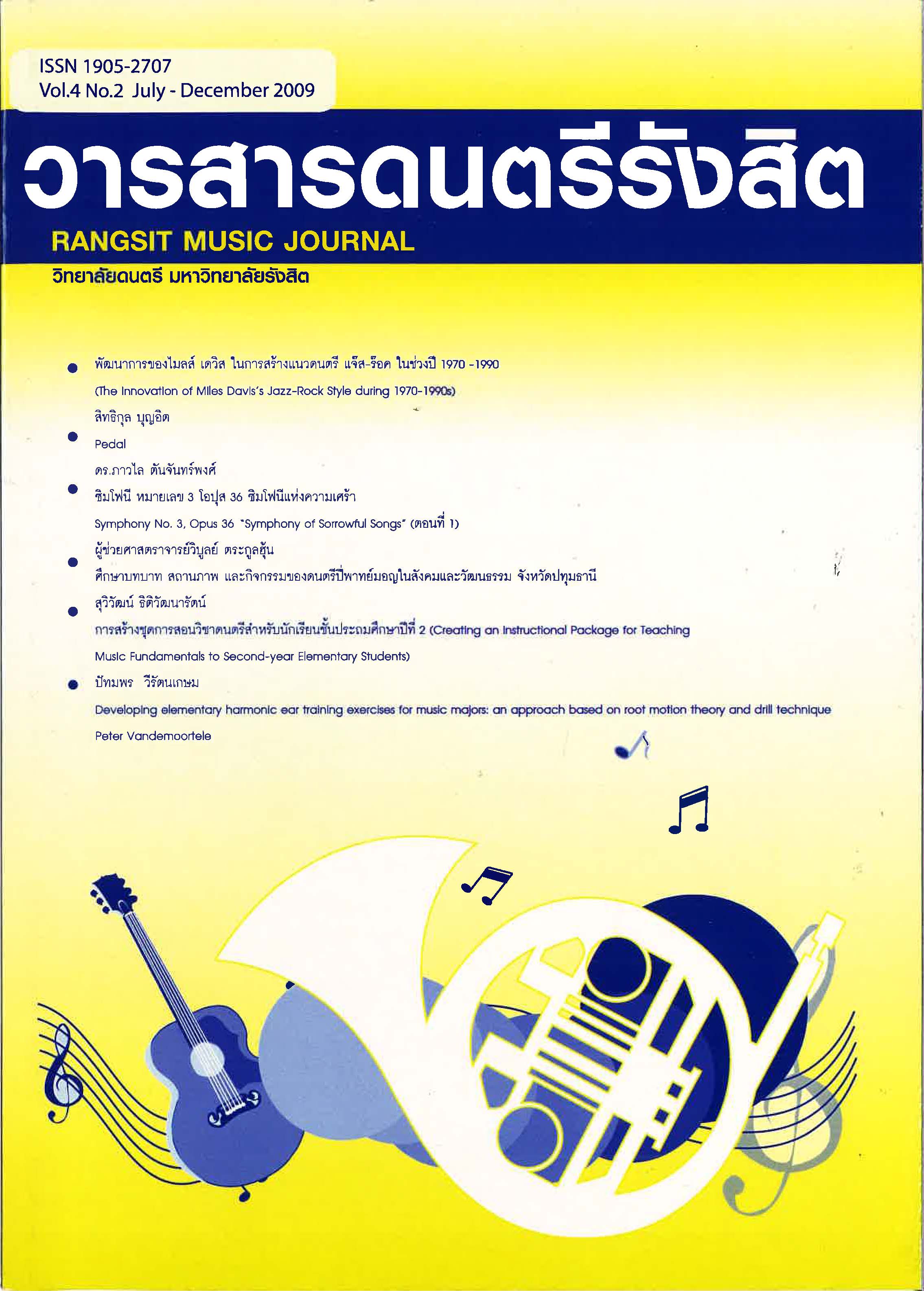Developing Elementary Harmonic Ear Training Exercises for Music Majors : An Approach Based on Root Motion Theory and Drill Technique
Keywords:
Ear Training Exercises, Root Motion Theory, Drill TechniqueAbstract
It is agreed among music educators that ear training in music programs is essential for success. The goal is to provide music students with critical listening skills that they will use routinely for the rest of their lives. In a good curriculum harmonic ear training is taught in combination with basic music theory. In real situations harmonic ear training skills tend to be neglected and in general, students have more problems doing harmonic ear training. The objective of this research was to develop elementary ear training exercises for music majors that uses root motion principles and drill technique, and to investigate if the method improved the accuracy of the subjects' ear training skills. The method was then tested with a sample group of 17 music major students using a pre and post test design. All students had previous ear training education to a certain degree. The results of the study showed a mean score of 64.82% at the pretest and 85.36% at the post test, an average increase of the mean after treatment of 20.54%.
References
2. Alvarez, M. (1980). A comparison of scalar and root harmonic aural perception techniques. Journal of research in music education, 229-235.
3. Benward, a. k. (1990). Ear training: A technique for listening. Dubuque: W.C. Brown.
4. Benward, B. (1969). Teacher's dictation manual in ear training. Iowa: W. C. Brown.
5. Bowman, D. (1993). Aural matters: A student's guide to aural perception at advanced level. London: Schott.
6. Costa-Giomo, E. (1994). Recognition of chord changes by 4 and 5 year old American and Argentine children. Journal of music education, p. 68-85.
7. Deutsch, M. (1971). A study of two approaches of ear training for elementary school children. Journal of Research in Music Education Vol. 19, p. 234-237.
8. Funk, C. H. (1975). An investigation with pedagogical implication into the perception of roots in trichords. Dissertation Indiana University .
9. Hofstetter, F. T. (1978). Computer-based recognitionof perceptual patterns in harmonic dictation exercises. Journal of Research in Music Education, p.111-119.
10. Hopkins. (2002). The Effects of Computer-Based Expository and Discovery Methods of Instruction on Aural Recognition of music concepts. Journal of Research in Music Education, p.131-144.
11. Howard, P. (1994). Sound investments. The musical times, p.467-475.
12. Killam, R. N. (1975). Interval recognition: identification of harmonic and melodic intervals. Journal of music theory. p.212-234.
13. Klonoski, E. (2006). Improving dictation as an aural-skills instructional tool. Music Educators Journal Vol. 93,p. 54-59.
14. Kodaly, Z. (1963). Three hundred thirthy-five elementary exercises edited with annotations by Percy M. Young. London: Boosey&Hawkes.
15. Kohs, E. (1980). Needs and problems in the teaching of undergraduate music theory. Music Theory Spectrum Vol. 2, p.135-142.
16. Kolosick, B. a. (1990). Ear training: a technique for listening.
17. Larson, R. (1977). Relationships between Melodic Error Detection, Melodic Dictation, and Melodic Sight Singing. Journal of Research in Music Education, p.264-271.
18. Laughlin. (2001). The use of notated and aural exercises as a pedagogigal procedures. Texas, Texas.
19. Lehrdahl. (2001). Tonal pitch place. Oxford: Oxford University Press.
20. Levin, R. a. (1988). Sight Siningn and Ear Training Through Literature. New York: prentice-Hall.
21. Levitin, D. (2006). This is your brain on music. London: Penguin books.
22. Marcio, B. (2003). Guided Discovery Tutoring and Schoenberg's Harmony Teaching Method: an Investigation. Retrieved from www.gsd.ime.usp.br/2005/papers.
23. Martinez, M. (1999). The Role of Repetition in Aural Identification of Harmonic Sequences. p.141 .
24. Meeus. (2000). Théorie des vecteurs harmoniques et théorie néo-riemannienne. Paris: Université de Paris Sorbonne.
25. _____. (2000). Toward a Post-Schoenbergian Grammar of Tonal and Pre-tonal Harmonic Progressions. Music Theory Online.
26. Piston. (1978). Harmony. New York: W. W. Norton & Company.
27. Potter, G (1990). Identifying successfull dictation strategies. Journal of Music Theory Pedagogy. 4 No.1, p.63-71.
28. Rameau. (1726). Nouveau système de musique théorique. Paris: Ballard.
29. _____. (1722). Traité de l'harmonie. Paris: Ballard.
30. Rodgers, M. (1984). Teaching Approaches in Music Theory: An Overview of Pedagogical Philosophies. Illinois: Southern Illinois University Press.
31. Salisbury, D. (1988). Effective Drill and Practice Strategies. Instructional designs for microcomputer courseware (32).
32. Salzer, F. (1962). Structural Hearing. New York: Dover.
33. Schenker. (1906). Harmonielehre. Translated by Elisabeth Mann Borgese. Chicago: University Chicago Press.
34. Schoenberg. (1967). Fundamentals of Musical Composition. London: Faber and Faber. Schoenberg. (1911). Theory of Harmony. Berkeley: University of California Press.
35. Schoenberg, A. (1954). Structural Functions of Harmony. New York: W. W. Norton & Company.
36. Thostenson, M. S. (1967). The Study and Evaluation of Certain Problems in Ear Training Related to Achievement in Sight Singing and Dicatation. Bulletin of the Council for Research in Music Education, p.14-35.
37. Tymoczko. (2000). A grammar for Elementary Tonal Harmony. Princeton University.







